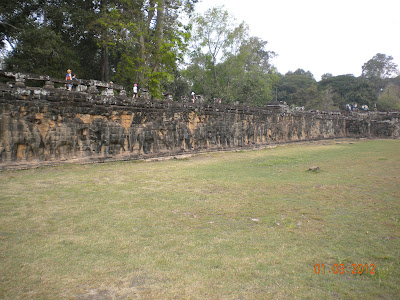These fabulous temples exceed those of Egypt and Greece in their scale and grandeur, and are at least their equal in craftsmanship. The first area we saw, Ankor Thom, is actually a fortified city of 10 square kilometres, built during the reign of Jayavarmin VII (1181-1219). The population is estimated to have been one million at its height. The houses, government buildings and palaces are all gone now, having been made of wood. Only the gods (and the King) were allowed to be housed in brick or stone, so only their temples have survived the centuries, along with the gates and walls of the great city.
Unfortunately, after the 15th century, Khmer civilization went into a decline, and the whole city gradually was abandoned. 400 years later, the jungle had reclaimed it, completely overgrowing the whole site. It was revived by the French colonialists, who reclaimed these great temples from the jungle once more. They painstakingly piled fallen stone blocks and recorded where they were found. Among many other things these records were cruelly destroyed by the Pol Pot regime, depriving Cambodians and the world of a method of reconstructing this great heritage.
We entered Angkor Thom by the 20 metre high South Gate, one of five gates to the city. The causeway across the moat leading to the gate has 54 stone gods to the left and 54 stone devils to the right
. After a drive further inside the city we reached the Bayon, having 54 towers that are each decorated with four faces of Avalokiteshvara,
a god whose face seemed to bear a close resemblance to that of Jayavarman VII himself!
It is beyond the scope of this recounting to relate all the myths shown in the statues and sculptures, and to describe the structural details of the many buildings along with their bas relief decorations. There are over 11,000 bas relief figures in this complex, occupying 1.2 kilometres.The few pictures I can post here will provide some small examples of the superb work that went into their creation.
Outside the Bayon is the 350 metre long Terrace of the Elepants,
a raised platform decorated for its whole length with life-sized stone elephants. It served as a giant reviewing stand for public ceremonies.
We next saw Ta Prom, another temple built at the behest of Jayavarma VII. It provides a graphic example of the power of the jungle to reclaim these temples. The awesome vitality and vigorous growth has lifted and encased blocks of delicately carved stone and had to be left intact at times for fear that to remove it would cause the original structures to collapse.
Some scenes from the film Lara Croft : Tomb Raider were filmed here.
Later in the afternoon we saw Angkor Wat, the largest religious structure in the world. We entered over a stone causeway that crossed a moat. My poor explanations would not do justice to this great monument so I'll just post a couple of pictures to show its grandeur.
It is incredible that these sites were largely unvisited until 1991, when the American bombing and the political turmoil in Cambodia had subsided and people began to visit as tourists. Now many thousands visit them every day, and the temples themselves are starting to show wear and tear from the pressures of this huge onslaught of tourism.
Saturday, March 17, 2012
Subscribe to:
Post Comments (Atom)




No comments:
Post a Comment